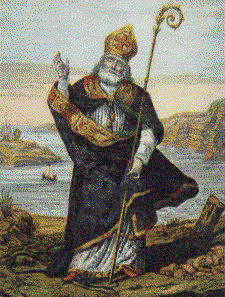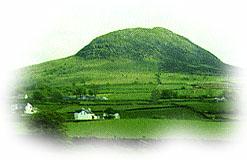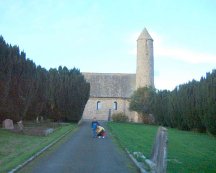 |
Every year on March 17, Irish men and women raise a toast or two in honour of St. Patrick, Ireland's patron saint. While St. Patrick's Day is undoubtedly the most popular Irish tradition to survive in the modern world, what do we really know about the man and his legend? |
Patrick was born in Britan or Brittany in France, about 387 AD. His given name was either Maewyn or Succat, (Celtic for 'clever in war'). Patricius was the name that he was given later in life by Pope Celestine after his consecration as a bishop. Later, this evolved into the name Patrick that we know him by today. We get this information from his own 'Confessio' (Confession) or 'magnum opus' which tells us much about his life. The following is an excerpt from the Confessio:
And later in the same document:
This defines exactly where he is from, a village called Bannaven Taberniae. But where is this? It is, according to Patrick, clearly in Brittanić. But is this Britain or Brittany? Many believe that this is Britain (the Roman province of Britain), but other information throws this belief into dispute. First there is the date of his capture at the age of sixteen. A simple calculation indicates St. Patrick was captured in the year 403 AD. It was at this time that the famous Irish King Niall of the Nine Hostages was raiding with his Scot (The Dal Riada tribe) and Pict (from Caledonia) allies into Britain and France. There is also the fact that Patricius (Patrick) had a great uncle through his mother, Conchessa, who was none other than St. Martin of Gaul (France). This information makes it clear that even if Patrick was not from France, at least his family was.
Before he was sold into slavery, Patrick was a self-described "heathen", but during his years in Antrim, he began to feel a greater awareness for God. Six years after his capture (c. 409 AD), he heard a voice telling him to return to his own country and that a ship was ready, but two hundred miles away. After three days at sea they landed in an uninhabited country. He returned to his parents for some time before entering a monastery in Gaul where he studied under St. Germain, Bishop of Auxerre. At one point Patrick dreamed that a man called Victorious handed him a large number of letters, one of which was headed "The Cry of the Irish". While reading this letter he heard voices from those he had known in Ireland calling "Holy Boy, we are asking you to come and walk among us again." He heeded the call and set sail for Ireland. Patrick landed in Ireland in 432 AD. According to Muirchu, writing in the seventh century, he arrived at Wicklow and made his way along the coast, by sea, landing at the mouth of the River Slaney. There a local chieftain Dichu was converted to christianity. Dichu gave Partick a barn (Sabhail) [Saul], as his first church. After 30 years of missionary work, Patrick retired to Saul in County Down, where he died around 461 AD. Patrick wanted to be buried in Armagh and started to make his way there. However his journey was interrupted by an Angel telling him to return to Saul.He was given the last rites by Bishop Tassach of Raholp. His buriel is described thus by Muirchu- John de Courcy in 1185, eager to prove his loyalty to St Patrick, cermonially reburied the bones of the three great Irish Saints, Brigid, Patrick and Columcille, under the altar of the then new Benedictine Abbey church, now Down Cathedral. The location of the bones was revealed in a vision to Bishop Malachy III who obtained papal approval for their re-burial. According to Anthony M Wilson, in his Book 'Saint Patrick's Town' -
A large stone, placed there in 1900 by the Belfast Naturalist Field Club, is located at the spot traditionally associated with the grave. Apart from the "Confessio", Patrick left only one other written source. This was a letter to the soldiers of Coroticus, a Welsh chieftain who had captured a number of recent Irish converts to Christianty, slaughtered some and sold the rest into slavery. These two documents are all that is actually known about him, his family, and what manner of man he was. One of the most recognizable aspects of St. Patrick's Day's are the celebratory parades. The first such parade in America was on March 17, 1737 in Boston, sponsored by the Charitable Irish Society of Boston to raise funds for ill, homeless, and unemployed Irishmen. As the saying goes, on this day "everybody is Irish!" Over 100 U.S. cities now hold Saint Patrick's Day parades. Presently, the largest North American parade takes place on New York City's Fifth Avenue, with an annual participation of over two hundred thousand people. Revolutionary War veterans originally began the Fifth Avenue parade in 1762 as a proud display of Irish heritage, and as an act of defiance against those who "didn't like the Irish very much". In Canada's Irish cities of Saint John and Miramichi, New Brunswick as well as St. John's, Newfoundland and even Montreal, Quebec, St. Patrick's Day is a much vaunted celebration that is marked every year with great enthusiasm and pride. Links: |
 Patrick was sold as a slave to the house of a Miliue (or Milchu), a Druid of the Dal Riada in what is now Antrim, Ireland. Here he remained for six years, tending sheep and taking care of the farm. During his stay at the house of Miliue, Patrick learned the language and customs of the land. These he added to his already proficient skills in Latin that he learned in his youth. Little did he know at the time, but these skills would have a profound affect on the rest of his life.
Patrick was sold as a slave to the house of a Miliue (or Milchu), a Druid of the Dal Riada in what is now Antrim, Ireland. Here he remained for six years, tending sheep and taking care of the farm. During his stay at the house of Miliue, Patrick learned the language and customs of the land. These he added to his already proficient skills in Latin that he learned in his youth. Little did he know at the time, but these skills would have a profound affect on the rest of his life. Saul (two miles north east of Downpatrick) is therefore by tradition the first church founded in Ireland by St Partick. Patrick got the attention of the High King (Laoghaire) by lighting a Paschal fire at Slane Hill, ten miles from Tara, where Laoghaire was conducting a pagan festival. By tradition lighting such a fire before the King's was a capital offence and Laoghaire sent soldiers to sieze Patrick. However, Patrick defeated the soldiers and succeeded in converting the King. Thereafter he was free to preach throughout Ireland with the permission of the King. Although he did not single-handedly convert all of Ireland, St. Patrick played a large role, and helped lay a significant portion of the groundwork in the form of monasteries, schools, and churches.
Saul (two miles north east of Downpatrick) is therefore by tradition the first church founded in Ireland by St Partick. Patrick got the attention of the High King (Laoghaire) by lighting a Paschal fire at Slane Hill, ten miles from Tara, where Laoghaire was conducting a pagan festival. By tradition lighting such a fire before the King's was a capital offence and Laoghaire sent soldiers to sieze Patrick. However, Patrick defeated the soldiers and succeeded in converting the King. Thereafter he was free to preach throughout Ireland with the permission of the King. Although he did not single-handedly convert all of Ireland, St. Patrick played a large role, and helped lay a significant portion of the groundwork in the form of monasteries, schools, and churches.